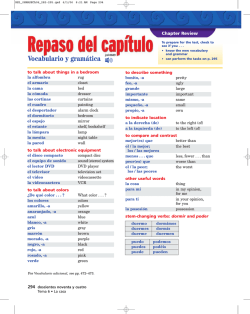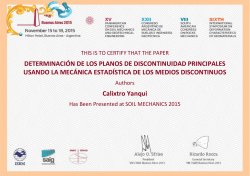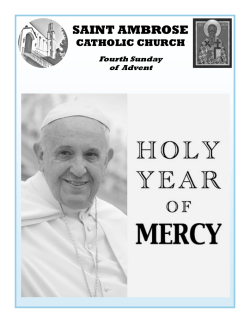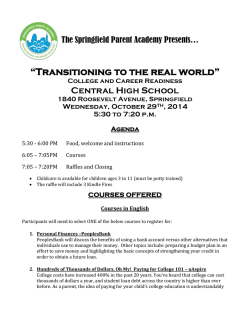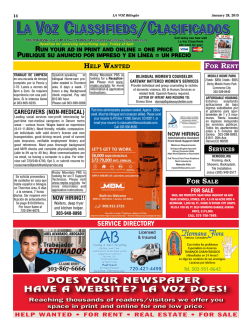
National Quali cations EXEMPLAR PAPER ONLY EP31/AH
AH National Qualications EXEMPLAR PAPER ONLY EP31/AH/01 Spanish Reading and Translation Date — Not applicable Duration — 1 hour 30 minutes Total marks — 50 SECTION 1 — READING — 30 marks Attempt ALL questions. Write your answers clearly, in English, in the answer booklet provided. In the answer booklet you must clearly identify the question number you are attempting. SECTION 2 — TRANSLATION — 20 marks Attempt to translate the whole extract. Write your translation clearly, in English, in the answer booklet provided. In the answer booklet you must clearly identify the section number you are attempting. You may use a Spanish dictionary. Use blue or black ink. Before leaving the examination room you must give your answer booklet to the Invigilator; if you do not, you may lose all the marks for this paper. © *EP31AH01* SECTION 1 — READING — 30 marks Attempt ALL questions Read the whole article carefully and then answer, in English, ALL the questions that follow. This article is about the disposal of unwanted electronic goods. Ciberbasura sin fronteras 5 10 15 20 25 En años recientes, el aumento del mercado internacional de bienes electrónicos y la reducción de la vida útil de muchos de estos productos han provocado un crecimiento vertiginoso de residuos electrónicos. Naciones Unidas estima que se producen entre veinte y cincuenta millones de toneladas de residuos electrónicos al año en todo el mundo. Cuando compramos un nuevo ordenador o cambiamos de móvil, ¿nos paramos a pensar qué ocurre con esa cantidad de basura electrónica que los países más desarrollados generan constantemente? En las afueras de Accra, la capital de la República de Ghana, se ubica el barrio de Agbogbloshie y, en él, se encuentra actualmente el mayor vertedero de residuos electrónicos de África y uno de los más grandes del mundo. Pilas de ordenadores viejos, lavadoras estropeadas y frigoríficos oxidados, la mayoría provenientes de Europa, se amontonan en este vertedero, donde la antigua basura se mezcla con nuevos desperdicios, cada vez más peligrosos y contaminantes. En cuanto al medio ambiente, lo más preocupante de estos vertederos que son también campos de reciclaje, es que las personas que realizan los trabajos de separación de materiales y de reciclaje, no cuentan con ninguna formación ni recursos técnicos para evitar que peligrosas sustancias químicas lleguen a los ríos o se dispersen en la atmósfera al separar los componentes reciclables de los no reciclables. La constante quema de plásticos PVC ha deteriorado enormemente la calidad del aire en Accra y en los poblados vecinos. En medio del vertedero, envueltos por el humo tóxico, cientos de jóvenes y adolescentes, sin ser conscientes de la peligrosidad de los elementos que manejan, destripan los aparatos para sacarles el cobre, el plomo y otros componentes que venden por unos pocos euros para poder dar de comer a sus familias. Peligrosas sustancias químicas, de comprobado efecto cancerígeno en los humanos, como por ejemplo el plomo y el cadmio, están siendo liberadas en las quemas de los materiales no reciclables y crean un enorme problema de salud pública en este país africano. La forma en la cual los países de Europa Occidental logran evadir los acuerdos internacionales y llevar numerosas toneladas de desechos electrónicos a los países de África, se sustenta en los acuerdos firmados entre la Unión Europea y los países de occidente africano, de ‘donación’ de equipos tecnológicos con el fin de disminuir la brecha digital entre ambas regiones del mundo. 30 Esta estrategia cínica de exportar aparatos electrónicos, el 75% inservible, que poseen peligrosos componentes tóxicos se mandan a países con una precaria o nula infraestructura para el reciclaje de este tipo de tecnología. Como consecuencia, se han deteriorado enormemente las condiciones ambientales y salubres de las poblaciones que residen en los suburbios de ciudades como Accra en Ghana o Lagos en Nigeria. 35 Según un estudio reciente de Greenpeace, solo el 25% de los equipos electrónicos ‘donados’ por Europa a Ghana se pueden usar y el país africano no tiene la capacidad técnica de evaluar la condición de los productos que llegan allí. Algunas veces aparatos que sólo necesitan un cable o alguna configuración sencilla de software son enviados directamente al vertedero de Agbogbloshie. 40 Este problema está directamente relacionado con la ‘obsolescencia programada’, una práctica empresarial que se inició a mediados del pasado siglo y que consiste en diseñar y producir los objetos de consumo con una vida útil relativamente corta para incentivar que la gente compre aún más. Page 02 45 50 55 De ello se ha ocupado recientemente el documental ‘Comprar, tirar, comprar’, emitido en Televisión Española, que denuncia esta práctica y habla de sus devastadoras consecuencias. Según ha señalado la realizadora del filme, Cosima Dannoritzer, “Esta práctica empresarial se ha convertido en la base de la economía moderna, a pesar de las terribles consecuencias medioambientales de un sistema que genera toneladas de residuos inútilmente”. No sólo los países donde se consumen estos artículos electrónicos sino también las empresas que los producen, deberían asumir la responsabilidad por los efectos negativos de esta práctica empresarial y adelantar programas efectivos de reciclaje. Esto impediría que los países más ricos y poderosos explotaran la escasa legislación de los países más pobres, situación que los convierte en ‘países basurero’. Las ‘donaciones de buena voluntad’ tienen como objetivo acortar la brecha digital entre los países contaminantes y los contaminados. Productores, consumidores y sobre todo los gobiernos deben evitar que la ciberbasura siga extendiéndose en interés de todo el planeta, porque tal y como nos decía uno de los responsables de Medio Ambiente de Ghana, “tenemos que darnos cuenta que el medio ambiente no tiene fronteras”. Page 03 MARKS Questions Re-read lines 1–11 1. The writer tells us about the current situation with unwanted electronic goods. (a) What has happened in recent years? 3 (b) What has the United Nations said about this situation? 2 2. The rubbish dump in Agbogbloshie is the biggest in Africa and one of the largest in the world. Give any other four details the writer provides about this rubbish dump. 4 Re-read lines 12–23 3. What environmental concerns does the writer have about the rubbish dump? 4 4. The young people who work in the dump face particular health issues. What are these? State any three things. 3 Re-read lines 33–46 5. Greenpeace has highlighted issues with the items that European countries donate. What are these issues? 3 6. There are strong views about the practice of “built-in obsolescence”. (a) What does the writer say about this practice? 2 (b) What does Cosima Dannortitzer say about this practice? State any two things. 2 7. Now consider the article as a whole. What is the writer’s overall purpose in writing about this subject? Justify your response with close reference to the points made and the language used. Page 04 7 SECTION 2 — TRANSLATION — 20 marks 8. Translate the underlined section into English: (lines 47–56). “No sólo los países donde . . . no tiene fronteras.” [END OF EXEMPLAR QUESTION PAPER] Page 05 AH National Qualications EXEMPLAR PAPER ONLY EP31/AH/01 Spanish Reading and Translation Marking Instructions These Marking Instructions have been provided to show how SQA would mark this Exemplar Question Paper. The information in this publication may be reproduced to support SQA qualifications only on a non-commercial basis. If it is to be used for any other purpose, written permission must be obtained from SQA’s Marketing team on [email protected]. Where the publication includes materials from sources other than SQA (ie secondary copyright), this material should only be reproduced for the purposes of examination or assessment. If it needs to be reproduced for any other purpose it is the user’s responsibility to obtain the necessary copyright clearance. © General Marking Principles for Advanced Higher Spanish: Reading and Translation This information is provided to help you understand the general principles you must apply when marking candidate responses to questions in this Paper. These principles must be read in conjunction with the Detailed Marking Instructions, which identify the key features required in candidate responses. (a) Marks for each candidate response must always be assigned in line with these General Marking Principles and the Detailed Marking Instructions for this assessment. (b) Marking should always be positive. This means that, for each candidate response, marks are accumulated for the demonstration of relevant skills, knowledge and understanding: they are not deducted from a maximum on the basis of errors or omissions. (c) Award a mark to each answer. Marks are not transferable between questions. (d) The marks available in this paper are as follows: (i) Questions 1–6 require candidates to provide answers based on comprehension of information from the text. The marks available for each question range between 1–4 marks. (ii) Question 7 is the overall purpose question. For this question candidates must draw meaning from their overall understanding of the text. There is a maximum of 7 marks available for full reference to the text and detailed comment. Pegged marks of 5/3/1 are given for degrees of reference to the text and comment. 0 marks will be given where candidates show little or no inferential skills or understanding of the overall purpose of the text. (iii) Question 8 is the translation. For this question candidates must translate the underlined section of the text. The section for translation will be divided into 10 sense units. For each sense unit, 2, 1 or 0 marks will be awarded: 2 marks for a full translation, 1 for partial translation, and 0 for an unsuccessful attempt. (e) For questions that ask candidates to ‘state’ or ‘give’, candidates must give a brief, accurate response/name. (f) We use the term ‘or any other acceptable answer’ to allow for the possible variation in candidate responses. Credit should be given according to the accuracy and relevance of candidate’s answers. Candidates may be awarded marks where the answer is accurate but expressed in their own words. (g) For live Reading Marking Instructions, there will be a process of illustrating other acceptable answers. Page 02 Detailed Marking Instructions: Section 1 — Reading Question 1 1 2 a b Max mark Expected Answer(s) • there has been an increase in the international market of electronic goods • there has been a reduction in the useful (shelf) life of (many of) these products • this has caused a huge growth in electronic waste 3 • the United Nations estimates that between 20 and 50 million tons of waste are produced • this is what is produced each year around the world 2 • you can find batteries from old computers • you can find broken/damaged washing machines and rusty fridges • most of the dumped items come from Europe • the old rubbish mixes with the new • there are more and more dangerous and poisonous items 4 • to stop dangerous chemicals getting into the river(s) or the air • when recyclable components are separated from nonrecyclable • constant burning of PVC plastic(s) • has enormously/seriously reduced air quality (in Accra and nearby) Page 03 Markers should use their professional judgement, subject knowledge and experience, and understanding to award marks to candidates’ responses. Markers should ignore extraneous material that does not contradict the answer. Any four of the above points for a maximum of 4 marks 3 Additional Guidance 4 Question Max mark Expected Answer(s) • they are exposed to toxic fumes/smoke • they are not aware of the danger of what they are handling • they are stripping down the machines to extract copper, lead, etc • dangerous chemicals, proven to be carcinogenic (are being released when materials are burned) 4 3 Any three of the above points for a maximum of 3 marks • only 25% of the equipment can be used • cannot evaluate the condition of the equipment • devices/equipment which just need a cable/simple software are binned 5 3 Accept any other ways of expressing these issues 6 a • (consumer) objects are designed and produced with a relatively short lifespan • to encourage people to buy more 2 b • it has become the basis of the economy • there are terrible consequences for the environment • it generates tons of waste unnecessarily 2 Any two of the above points for a maximum of 2 marks Page 04 Additional Guidance Question 7 Max mark Expected Answer(s) Possible responses include: 7 The overall purpose is: • To criticise the practice of sending unwanted electronic goods from Europe to Africa. Any other valid purpose should be accepted. To justify the overall purpose stated, the candidate's analysis of the text could include the following: Additional Guidance Pegged Marks 7 OR 5 Content and Language used: • It is not transfer of goods but rather the creation of rubbish tips, ie ‘goods’ have become waste. • Writer exposes the hypocrisy behind the ‘donations’ made by European countries. • He/she explains in detail the negative impact on African communities, eg health and environmental consequences. • He/she uses powerful images of young people/teenagers in danger to evoke sympathy of reader. • He/she mentions that the majority (75%) of equipment is not reusable anyway. • He/she makes only passing reference to positive aspects, ie helping countries to bridge the digital gap. • Writer concludes on a pessimistic note and issues a stark warning about future of planet. • Writer asks a rhetorical question near the beginning to persuade reader to think of consequences of the disposal of electronic waste. • Writer’s use of inverted commas, eg “donados” is indicative of ironic tone. • His/her listing of negative adjectives/images paints a bleak picture, eg ‘estropeadas’ ‘oxidadas’, as does the use of emotive/extreme language like ‘cínica’ and ‘devastadora’. Page 05 3 OR 1 0 Criteria The candidate provides a clear, concise and reflective answer, drawing inferences which are entirely appropriate, analytical and which demonstrate a sophisticated and accurate reading of the text. The answer clearly relates to the advice given in the Expected Answers column, or any other equally appropriate response. The candidate provides an answer which may contain some degree of misreading, but which offers evidence of appropriate inferencing skills. The candidate may, however, tend to supply information from the text with little attempt to draw inferences. The candidate’s answer simply provides information to be found in the text with no attempt to draw inferences. Detailed Marking Instructions: Section 2 — Translation Question 8 Max mark Expected Answer(s) • No sólo los países donde se consumen estos artículos electrónicos • (it is) not only (the) countries where these electronic goods are used • sino también las empresas que los producen, • but also (the) firms/companies/businesses that produce/make/manufacture them, • deberían asumir la responsabilidad por los efectos negativos de esta práctica empresarial • ought to/should assume/take (on)/accept/shoulder (the) responsibility for the negative/harmful effects of this business practice • y adelantar programas efectivos de reciclaje. • and bring forward/progress effective recycling programmes/ programmes for/of recycling. • Esto impediría que los países más ricos y poderosos • This would prevent/stop the richest and most powerful countries • explotaran la escasa legislación de los países más pobres, • (from) exploiting the scant/minimal/scarce/limited/ meagre legislation in/of the poorest countries, • situación que los convierte en ‘países basurero’. • (a situation) which turns/transforms/changes/is turning/ them into ‘rubbish/garbage/rubbish dump/refuse/waste countries’. Page 06 20 Additional Guidance The translation into English is allocated 20 marks. The text for translation will be divided into a number of sense units. Each sense unit is worth 2 marks, which will be awarded according to the quality and accuracy of the translation into English. In assessing the candidate’s performance, the descriptions detailed below will be used. Each sense unit will be awarded one of the marks shown. 2 – Good: Essential information and relevant details are understood and conveyed clearly and accurately, with appropriate use of English. 1 – Satisfactory: Essential information is understood and conveyed clearly and comprehensibly, although some of the details may be translated in an imprecise or inaccurate manner. The key message is conveyed in spite of inaccuracies and weaknesses in the use of English. 0 – Unsatisfactory: The candidate fails to demonstrate sufficient understanding of the essential information. Question Max mark Expected Answer(s) • Las ‘donaciones de buena voluntad’ tienen como objetivo acortar la brecha digital entre los paises contaminantes y los contaminados. • The 'charitable donations' aim to bridge the digital divide between polluting and polluted countries. • Productores, consumidores y sobre todo los gobiernos deben evitar que la ciberbasura siga extendiéndose en interés de todo el planeta, • Producers, consumer and especially governments must avoid cyber rubbish spreading in the interest of all the planet, • porque tal y como nos decía uno de los responsables de Medio Ambiente de Ghana, “tenemos que darnos cuenta que el medio ambiente no tiene fronteras”. • Because as one of those responsible for the environment in Ghana told us, “we have to realise that the environment does not have borders”. [END OF EXEMPLAR MARKING INSTRUCTIONS] Page 07 Additional Guidance
© Copyright 2025
